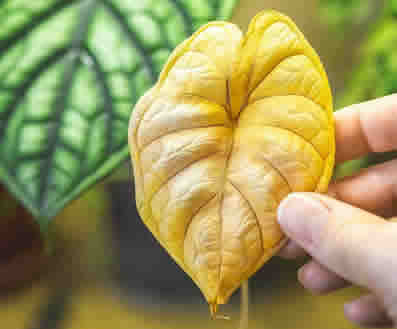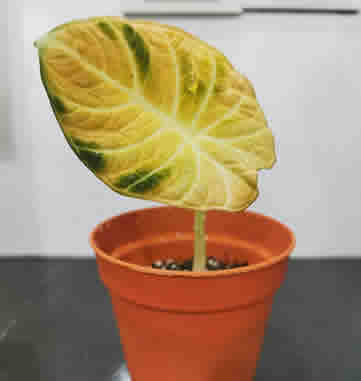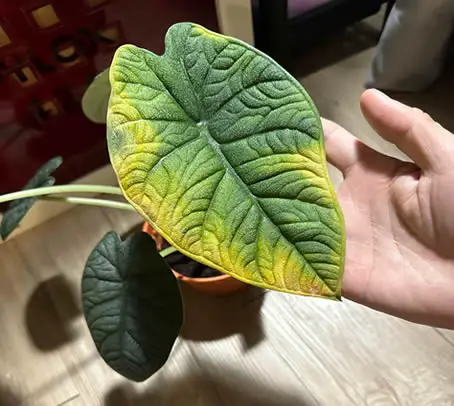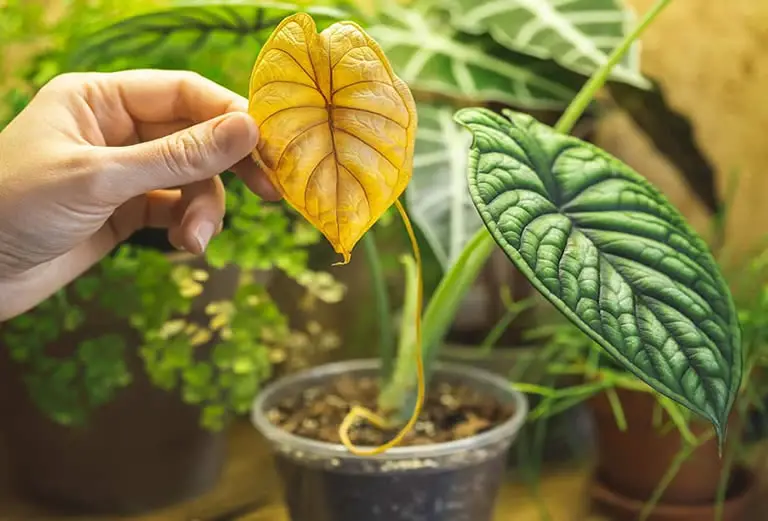Alocasias are undeniably stunning, but they aren’t shy about letting you know when something’s off. One of the clearest warning signs? Yellowing leaves. If your Alocasia is suddenly looking more sun-faded than lush and green, don’t panic—it’s usually fixable.
In this guide, we’ll walk through all the common reasons Alocasia leaves turn yellow and exactly how to help your plant bounce back.
Table of Contents
- Understanding Why Alocasias Are Prone to Yellow Leaves
- 1. A Little Yellowing Is Normal
- 2. Overwatering Is the #1 Culprit
- 3. Poor Water Quality Can Cause Leaf Discoloration
- 4. Soil Structure Plays a Big Role
- 5. Not Enough (or Too Much) Light
- 6. Low Temperatures Can Trigger Leaf Yellowing
- 7. Humidity Matters More Than You Think
- 8. Nutrient Deficiency Could Be the Cause
- 9. Overfertilizing Can Be Just as Harmful
- 10. Pests Could Be the Sneaky Culprit
- 11. Acclimation and Dormancy Are Also Possible
- Should You Cut Off Yellow Alocasia Leaves?
- Can Yellow Alocasia Leaves Turn Green Again?
- Final Thoughts
Understanding Why Alocasias Are Prone to Yellow Leaves
Native to tropical regions of Asia and Eastern Australia, Alocasias are used to warm temps, bright light, and high humidity.

When grown indoors, especially in climates that don’t naturally mimic these conditions, their leaves can easily turn yellow from stress.
Different species can have slightly different care preferences, so knowing what kind of Alocasia you’re working with—whether a Jewel variety or a larger species—can help you troubleshoot more effectively.
Let’s break down each possible cause of yellowing leaves and how to fix them.
1. A Little Yellowing Is Normal
Not every yellow leaf is a cause for concern.
Like many plants, Alocasias naturally shed their older leaves as new ones emerge.
These older leaves will gradually yellow and die off, especially those around the bottom of the plant.
As long as your plant is still producing fresh, healthy foliage, this is just part of the life cycle.
2. Overwatering Is the #1 Culprit
If your Alocasia’s leaves are turning yellow and drooping, especially from the bottom up, overwatering is the most likely issue.
These plants don’t like to sit in wet soil.
What to do:
-
Gently unpot your plant and inspect the roots
-
Healthy roots are white and firm; mushy, brown, or foul-smelling roots indicate rot
-
Trim away damaged roots and repot into fresh, fast-draining soil
-
Let the top 2–3 inches of soil dry out before watering again
Also make sure your pot has drainage holes. A decorative pot without drainage can be a hidden hazard.
3. Poor Water Quality Can Cause Leaf Discoloration
If your Alocasia is developing yellow leaves along with brown tips or leaf spots, minerals or chemicals in your tap water could be to blame.

Try switching to:
-
Rainwater
-
Distilled water
-
Filtered water Or at least let tap water sit out overnight to help dissipate chlorine.
4. Soil Structure Plays a Big Role
Even with perfect watering habits, poor soil can trap too much moisture around the roots.
Alocasias like a loose, well-aerated mix that allows air to flow around their roots.
Try:
-
For Jewel Alocasias: a chunky, orchid-style mix with lots of perlite and bark
-
For standard varieties: potting soil mixed with perlite, bark, or pumice
Peat moss can be useful but in moderation—too much holds excess moisture.
5. Not Enough (or Too Much) Light
Lighting is a balancing act. Alocasias want bright, indirect light—but not direct sun.
Signs of poor lighting:
-
Yellow, pale, or leggy growth = not enough light
-
Yellow or scorched leaves = too much direct sunlight
Your Alocasia will likely need to live near a bright window but behind a sheer curtain.
If seasonal light drops in fall or winter, consider supplementing with a grow light.
6. Low Temperatures Can Trigger Leaf Yellowing
Alocasias thrive in warmth.
Temperatures below 55°F (13°C) can trigger stress or dormancy, and yellowing leaves are often the first sign.
Keep them cozy:
-
Ideal range: 65–85°F (18–29°C)
-
Protect from drafts or heat vents
-
Avoid sudden temperature swings
Some growers use seedling heat mats to warm the roots—especially helpful in winter.
7. Humidity Matters More Than You Think
Alocasias love high humidity. If your home is dry—especially in winter—yellowing leaves and crispy tips may start to appear.
Raise humidity by:
-
Grouping tropical plants together
-
Placing a pebble tray with water under or near your plant
-
Running a humidifier (this is often the most effective solution)
Ideally, aim for at least 60% humidity. Some Alocasias will tolerate less, but they’ll look their best with more.
8. Nutrient Deficiency Could Be the Cause
If your Alocasia hasn’t been fertilized in a while, yellowing could signal a nutrient shortfall—especially if older leaves are fading.
How to feed it:
-
Use a diluted balanced liquid fertilizer every 2–4 weeks during the growing season
-
If you’re new to fertilizing, start slowly and observe your plant’s response
-
Organic options like worm tea or fish emulsion are gentler on sensitive roots
Once a healthy routine is in place, new foliage should emerge vibrant and strong.
9. Overfertilizing Can Be Just as Harmful
Too much of a good thing can burn the roots.
Signs include brown tips, yellowing leaves, and stunted growth.
Fix it by:
-
Flushing the soil with clean water to wash away excess salts
-
Holding off on feeding until the plant recovers
-
Reducing fertilizer strength to half or quarter strength going forward
Only fertilize during spring and summer—Alocasias don’t need it during dormancy.
10. Pests Could Be the Sneaky Culprit
Aphids, mealybugs, thrips, and spider mites all love Alocasia leaves.

They sap nutrients, weaken the plant, and cause yellow, mottled, or speckled foliage.
Check for:
-
Tiny white dots or webs
-
Insects clustering on new growth or undersides of leaves
Treat with:
-
Insecticidal soap
-
Neem oil spray
-
A thorough rinse in the shower (protect the soil!)
Repeat treatments weekly until the problem is gone. Isolate the plant if pests are present.
11. Acclimation and Dormancy Are Also Possible
If your Alocasia has recently been moved—or brought inside after a summer outdoors—it may need time to adjust.
Yellow leaves can result from shock, especially if lighting, temperature, or humidity suddenly changed.
Tips:
-
Don’t panic and move the plant again unless conditions are truly poor
-
If the plant goes dormant, reduce watering and give it time to rest
-
New growth will resume in a few weeks or months
Should You Cut Off Yellow Alocasia Leaves?
If a leaf is fully yellow and limp, go ahead and prune it. But if it’s only partially yellow, leave it alone.
It may still be photosynthesizing and helping the plant recover.
The only exception is disease—remove any infected leaves immediately to prevent spread.
Can Yellow Alocasia Leaves Turn Green Again?
Unfortunately, no. Once the leaf turns yellow, it’s not going back.
Focus on identifying the root cause and providing the right care so future leaves stay green and healthy.
The only time a yellowed leaf might recover is if it faded slightly due to too much light and hasn’t been damaged.
Final Thoughts
A yellow leaf on your Alocasia doesn’t mean you’ve failed—it’s just your plant’s way of saying something needs tweaking.
Most of the time, the fix is simple: adjust your watering, check the light, or bump up the humidity.
With a little observation and care, your Alocasia will be back to lush, tropical glory in no time.
Let me know if you’d like this formatted into a care card or infographic—happy to help make it even more reader-friendly!
Related Articles
Alocasia Plant Care: Indoor & Outdoor Care Guide
Alocasia Water Guide. Watering Alocasia & Growing Alocasia In Water
Understanding Alocasia Dormancy: What It Is, Why It Happens, and How to Handle It
How to Keep Your Alocasia Wentii Thriving: Complete Care Guide
Alocasia Dragon Scale Care Guide: How to Keep This Jewel Alocasia Thriving
Why Is My Alocasia Drooping? Common Causes and How to Revive It

